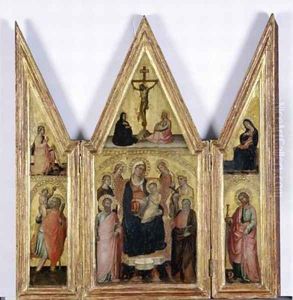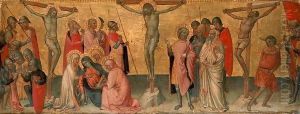di Bartolomeo di Biagio Martino Paintings
Di Bartolomeo di Biagio Martino, more commonly known as Bartolomeo della Gatta, was an Italian painter, illuminator, and architect, active during the early Renaissance period. Born in 1431 in Florence, Italy, he was a significant figure in the transition from the late Gothic to the early Renaissance style. His contributions to art, particularly in the realm of religious painting and manuscript illumination, reflect the evolving artistic sensibilities of his time, characterized by a greater emphasis on naturalism and human emotion.
Bartolomeo della Gatta took his monastic name from the Camaldolese monastery of San Giovanni Evangelista in Florence, where he took his vows and where he was trained in the arts. His works are noted for their detailed precision and use of color, which he likely developed under the influence of his contemporaries, such as Fra Angelico, with whom he is believed to have collaborated. Despite his monastic life, della Gatta engaged actively with the broader artistic community, contributing to the cultural and artistic developments of the Renaissance.
Throughout his career, Bartolomeo della Gatta was commissioned to work on several significant projects, including frescoes for the Cathedral of Arezzo and the Vatican's Sistine Chapel, where he painted alongside other Renaissance masters like Sandro Botticelli, Domenico Ghirlandaio, and Pietro Perugino. His work in the Sistine Chapel, however, was later removed to make way for Michelangelo's Last Judgment. Despite this, his contributions to the chapel and other sites have cemented his reputation as a skilled artist of the Renaissance.
Della Gatta's artistry extended beyond painting; he was also recognized for his talent in manuscript illumination and as an architect. His architectural works include designs for the Abbey of Monte Oliveto Maggiore near Siena, showcasing his versatility and the breadth of his skills. Bartolomeo della Gatta's death in 1507 marked the end of a career that had significantly influenced the religious and artistic landscape of Italy during one of its most transformative periods. His legacy is preserved in the works that survive him, reflecting the vibrancy and depth of Renaissance art.

